Cierva Cove
Overnight, we had moved back north at slow speed towards Cierva Cove which is located on the west coast of Graham Land. The cove was named in 1960 in honour of Juan de la Cierva, inventor of the ‘Autogyro’, regarded as the first successful rotary-wing aircraft. When I got up, visibility was poor because it was snowing and the temperature was around minus one or two Celsius.
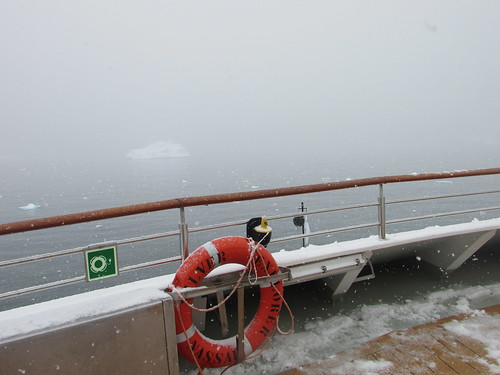
Snow at Cierva Cove. View looking forward from the observation deck. The 'black ball' visible on the flagstaff indicates to other vessels that we are at anchor.
90 minute Zodiac tours were offered, with groups 3 and 4 leaving the ship at 8.00 a.m. and groups 1 and 2 leaving the ship at 10 a.m. Since I was in group 1, I had plenty of time to work on the computer before getting ready to leave the ship.
I was in a smaller Zodiac with just six passengers and Steffan driving. It was still snowing but not hard and the sheltered location in the long cove minimised the wind so I found it quite pleasant, although the contrast with the previous day’s weather was very pronounced.
Tall snow-covered mountains loomed on both sides of us, with bare rock outcrops in places. There was brash ice and icebergs of various sizes in all directions. We were quite close to an Argentinian Research Station on the mountain side called Base Primavera which carries out botanical research during the summer but did not appear to be staffed this season as yet.
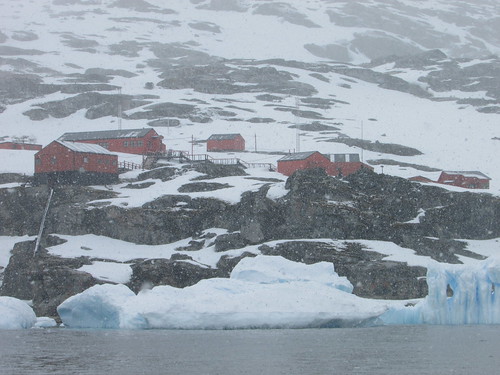
Zodiac Cruise - Cierva Cove: Argentinian Base Primavera in the snow.
What was noticeable was the apparent good state of maintenance of the cluster of wooden buildings forming the base and the number of tall radio transmitting masts which appeared to be required. There were various groups of penguins near Base Primavera, some standing statue-like, others lying on their front.
As we moved further along the cove, the sheer variety of icebergs was noticeable, both in size and in the fantastical shapes they acquire as they thaw, roll in the sea with the change of centre of gravity and then re-freeze. Unless there’s a man-made object, like a Zodiac, nearby it’s very hard to determine how big any lump if ice is, but the tendency is to underestimate scale – the human mind is reluctant to accept how large a chunk of frozen water can be.
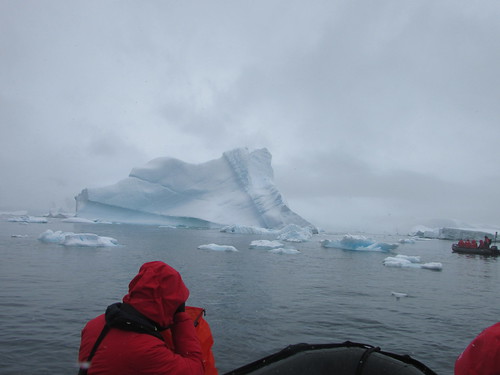
Zodiac Cruise - Cierva Cove
Perhaps most striking aspect of icebergs is the blue colouration that parts of the ice, particularly crevices, can display - not a faint, bluish tinge but often a bright, electric blue as if emanating from some internal source of illumination.
We came upon a flat piece of sea ice, roughly fifty feet across with a single Weddell seal stretched out on top. He opened his eyes to survey the strange creatures approaching but showed no interest in disturbing his relaxation as we sailed around his temporary ‘home’ twice.
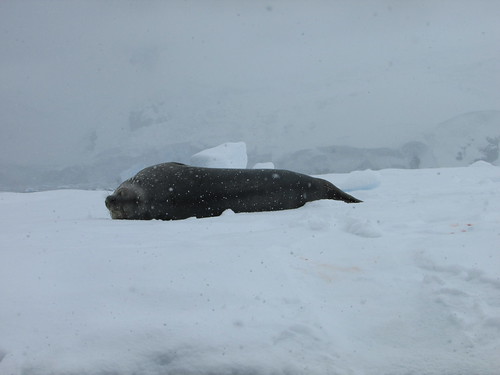
Zodiac Cruise - Cierva Cove: Weddell seal relaxing.
Further into the cove, we found a group of five Gentoo penguins relaxing quietly on a humped section of sea ice about fifty feet across. In the background, we could see the glacier front of the Sikorsky Glacier. This glacier appeared to have a very ragged, overhanging front so we were not surprised, a few minutes later, when a rumble like thunder announced a calving.
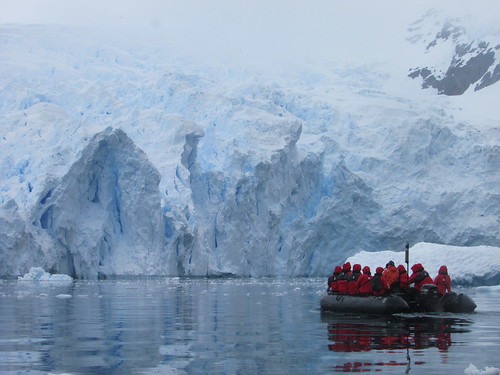
Zodiac Cruise - Cierva Cove: Face of the Sikorsky Glacier.
Presently, we could clearly see the small wave propagating across the surface of the sea produced by the ice collapsing from the glacier face. When this wave passed the mass of sea ice with the penguins, it set the ice slowly oscillating. This motion appeared to disturb one of the penguins who made his way towards the edge of the sea ice and the others followed, as if playing “follow my leader”. The leading penguin dived into the water followed, in turn, by each of the other penguins, as if performing a synchronised swimming display.

Zodiac Cruise - Cierva Cove: Gentoo penguins enter the water one after another.
Mikkelsen Harbour
Whilst the guests enjoyed lunch, the ship sailed towards Mikkelsen Harbour - a rocky islet in a bay on the southern side of Trinity Island in the Palmer Archipelago. Once again, the variability of Antarctic weather asserted itself. The entrance to the bay is via a narrow channel and, on our approach to this channel, the Captain determined that the local wind was too strong for the ship to enter in safety. Since the wind was expected to abate, it was decided that our ship would wait an hour or so in the hope of entering the channel and still making a landing.
After around one hour’s wait, the wind did lessen and we passed through the channel, intending to anchor in front of the islet where we could see the Argentine emergency refuge hut.
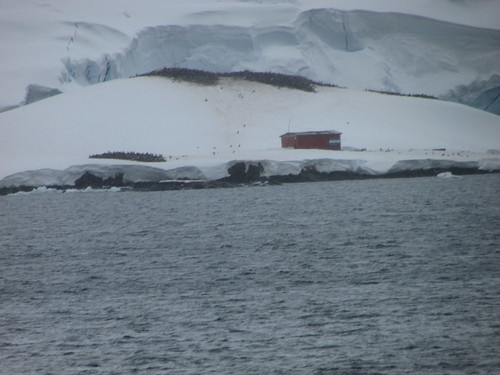
Penguins and the Argentine emergency refuge hut at Mikkelsen Harbour.
However, sea ice in the area started to move, preventing anchoring. Since there was deemed to be insufficient clear water around the ship to ‘hold station’ without anchoring, the Captain decided that, on safety grounds, the planned landing would be abandoned. So the ship was turned and exited through the narrow channel, then continuing north again.
Instead, Luke gave an interesting lecture titled ‘Fishing in Antarctica’ at 5.00 p.m., there was a ‘Recap and Briefing’ at 6.45 p.m. and the accustomed splendid dinner in the restaurant at 7.30 p.m.
Related Posts
Next post describing this trip: Visiting the Antarctic Peninsula (3).
All posts describing this trip: Chilean Fjords.
Just posts on the Antarctic segment: Antarctic Peninsula.
My pictures
Where necessary, clicking on an image above will display an 'uncropped' view or, alternately, my pictures from this (and earlier) trips may be selected, viewed or downloaded, in various sizes, from the albums listed:-
Zodiac Cruise - Cierva Cove 2016.
All my pictures taken in Antarctica on both this visit and my earlier visit in 2008 are in the collection here.
[Links to pictures added, pictures added: 2-Feb-2017]
